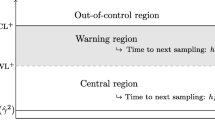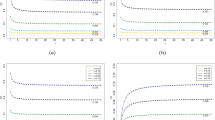Abstract
In practical applications of multivariate sliding window (SW) control charts, a considerable amount of difficulty lies in selecting parameters related to the window size and to the disposal of past observations. Although widely used for pattern recognition problems, to the best of the authors’ knowledge, there have been no comparative analyses of the efficiencies of multivariate SW schemes and more traditional and easy-to-apply control charts, such as Hotelling’s T 2 and the multivariate exponentially weighted moving average (MEWMA) control charts. The present work applies a transformed statistic called confidence control chart (CCC), which standardizes all the control charts in the 0–01 interval to improve visualization, and comparisons are made in terms of the average run length (ARL). Therefore, the purpose of this paper is to present a simulation study to compare the inertial effect of estimating the actual mean vector through the SW and the MEWMA schemes. Three types of SW schemes were tested, including uniform, linear, and exponential weights. In addition to providing equivalences between the smoothing parameter of the MEWMA method and the window sizes for the bivariate case, the results show that multivariate SW schemes suffer from the inertial effect more than MEWMA charts. In this sense, the user is encouraged to apply both control charts to avoid detection delay.
Similar content being viewed by others
References
Alipour H, Noorossana R (2010) Fuzzy multivariate exponentially weighted moving average control chart. Int J Adv Manuf Technol 48(9-12):1001–1007
Azam M, Aslam M, Jun C (2015) Designing of a hybrid exponentially weighted moving average control chart using repetitive sampling. Int J Adv Manuf Technol 77(9-12):1927–1933
Bersemis S, Psarakis S, Paranetos J (2007) Multivariate statistical process control charts: an overview. Qual Reliab Eng Int 23:517–543
Bhattacharyya A (1943) On a measure of divergence between two statistical populations defined by their probability distributions. Bull Calcutta Math Soc 35:99–109
Caballero Morales S (2013) Economic statistical design of integrated x-bar-s control chart with preventive maintenance and general failure distribution. PLoS ONE 8(3):e59,039. doi:10.1371/journal.pone.0059039
Chernoff H (1952) A measure of asymptotic efficiency for tests of a hypothesis based on the sum of observations. Ann Math Stat 23(4):493–507
Costa A, Machado M (2009) A new chart based on sample variances for monitoring the covariance matrix of multivariate processes. Int J Adv Manuf Technol 41(7-8):770–779
Crosier R (1988) Multivariate generalizations of cumulative sum quality-control schemes. Technometrics 30 (3):291–303
Faraz A, Saniga E (2013) Multiobjective genetic algorithm approach to the economic statistical design of control charts with an application to xbar and s 2 charts. Qual Reliab Eng Int 29:407–415. doi:10.1002/qre.1390
Fukunaga K (1990) Introduction to statistical pattern recognition. Academic Press, Boston
Guh R, Shiue Y (2005) On-line identification of control chart patterns using self-organizing approaches. Int J Prod Res 43(6):1225–1254. doi:10.1080/0020754042000268884
Guh R, Shiue Y (2008) An effective application of decision tree learning for on-line detection of mean shifts in multivariate control charts. Comput Ind Eng 55(2):475–493. doi:10.1016/j.cie.2008.01.013
Hachicha W, Ghorbel A (2012) A survey of control-chart pattern-recognition literature (1991-2010) based on a new conceptual classification scheme. Comput Ind Eng 63:204–222. doi:10.1016/j.cie.2012.03.002
Hawkins M, Maboudou-Tchao E (2012) Multivariate exponentially weighted moving covariance matrix. Technometrics 50:155–166
Hotelling H (1947) Multivariate quality control—illustrated by the air testing of sample bombsights. Tech Stat Anal:111– 184
Hwarng H, Hubele N (1993) Back-propagation pattern recognizers for control charts: Methodology and performance. Comput Ind Eng 24(2):219–235. doi:10.1016/0360-8352(93)90010-U
Hwarng H (1993) Hubele, N.: \(\widehat {X}\) control chart pattern identification through efficient off-line neural network training. IIE Trans 25(3):27–40. doi:10.1080/07408179308964288
Lowry C, Montgomery D (1995) A review of multivariate control charts. II Trans 6(27):800–810
Lowry C, Woodall W, Rigdon S (1992) A multivariate exponentially weighted moving average control chart. Technometrics 34(1):46–53
Moraes DAO, Oliveira FLP, Quinino RC, Duczmal LH (2014) Self-oriented control charts for efficient monitoring of mean vectors. Comput Ind Eng 75:102–115
Niaki S, Memar A (2009) A new statistical process control method to monitor and diagnose bivariate normal mean vectors and covariance matrices simultaneously. Int J Adv Manuf Technol 43:964–981. doi:10.1007/s00170-008-1774-0
Nikiforov I (2001) A simple change detection scheme. Signal Process 81:149–172. doi:10.1016/S0165-1684(00)00198-5
Rao CR (1947) The problem of classification and distance between two populations. Nature:30
Rao CR (1949) On the distance between two populations. Sankhya: The Indian Journal of Statistics 9:246– 248
Reinolds J, Marion R, Zachary G (2008) Combinations of multivariate shewhart and mewma control charts for monitoring the mean vector and covariance matrix. J Qual Technol 40:381– 393
Seber G (1984) Multivariate observations. Wiley, New York
Sheu S, Tai S (2005) Generally weighted moving average control chart for monitoring process variability. Int J Adv Manuf Technol 30(5-6):452–458
Teoh W, Khoo M, Teh S (2013) Optimal designs of the median run length based double sampling x-bar chart for minimizing the average sample. PLos ONE 8(7):e68,580. doi:10.1371/journal.pone.0068580
Therrien C (1989) Decision estimation and classification, an introduction to pattern recognition and related topics. John Wiley & Sons
Tracy N, Young J, Mason R (1992) Multivariate control charts for individual observations. J Qual Technol 24:88– 95
Tsai T, Lin J, Wu S, Lin H (2005) On estimating control limits of x?? chart when the number of subgroups is small. Int J Adv Manuf Technol 26(11-12):1312–1316
Yen F, Chong K, Ha L (2013) Synthetic-type control charts for time-between-events monitoring. PLoS ONE 8(6):e65,440. doi:10.1371/journal.pone.0065440
Author information
Authors and Affiliations
Corresponding author
Rights and permissions
About this article
Cite this article
Moraes, D.A.O., Oliveira, F.L.P., Duczmal, L.H. et al. Comparing the inertial effect of MEWMA and multivariate sliding window schemes with confidence control charts. Int J Adv Manuf Technol 84, 1457–1470 (2016). https://doi.org/10.1007/s00170-015-7822-7
Received:
Accepted:
Published:
Issue Date:
DOI: https://doi.org/10.1007/s00170-015-7822-7




